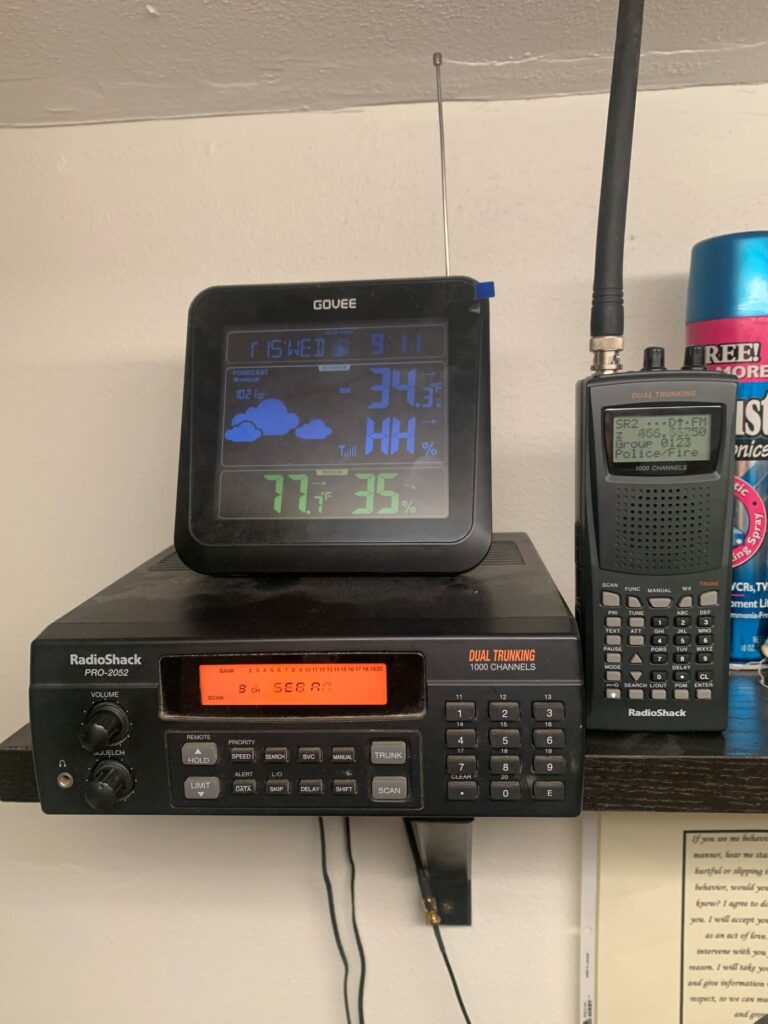Six months ago, I had zero scanners and now I have two. Most work days I will have both of them on because I have a lot to learn still. I figured out a couple of channels by using Radio Reference. The real reason that I have two is that I would like to have one not just in my office but also upstairs, where we live.

My newest scanner (the handheld) has a neat, preprogrammed set of frequencies that are commonly used by emergency services. I have learned at least three new channels that I didn’t see on the Radio Reference database. Eventually, I am going to add them to my stationary scanner so that I get a more comprehensive listen to what is going on.
The thing about the pre-programmed scan list is that there are so many channels that it takes it takes about 5 seconds to scan through and I am pretty sure I am missing most of the conversations that are taking place. I think this because sometime I catch the tail end of the conversation on the handheld that I have been hearing on the larger scanner. This means that there is a meaningful limit to the number of channels to put into a scan group.
Another cool thing with the handheld is that is have several built in scan-lists. For instance there is a CB list. So I could run the scanner to determine a good channel to talk on. It also has a VHF channel list. This would be more helpful in a marine environment where I could listen to Coast Guard radio. Most of those channels are reserved for certain purposes like ships and harbors.
Do I need to have two scanners running? I don’t think so but once again there does seem to be a practical limit to the number of channels that effectively are scanned in any one group. I am doing it to collectively build a better list of channels. I cant say if the ones on Radio Reference are old or out of date or what. I could imagine a situation where you might not want the scanner to jump to public works while things were getting hot.
Currently, of the two I am liking the handheld better. It has an electric plug as well as batteries making it portable. It seems to get decent reception despite the fact I have the desktop version plugged into an exterior antenna. My only knock is the programming and use seems to be more complicated and less intuitive than the desktop. Actually, I have to read the manual each time I want to do anything for either. So, that is not saying too much.
Both of these I purchased from eBay for about $50 each. Don’t be surprised to find them for a significantly higher price though. You just have to keep an eye out and jump on the opportunity for lower price. What you might find for higher priced models is more accessories or possibly better condition. Then again, just keep watching for a good one.
I have yet to figure out how to handle trunking (or digital channel skipping) and that may be why I have not really figured out the Law Enforcement frequencies. Be aware that technology moves on and buying used may not get you what you want to hear. Do the best you can to research what technology your local agencies are using and compare that to the used models out there. Both of mine support dual trunking but not triple trunking. Fire, medical, public works are all using standard radio.
What I am saying is be wary of paying too much for something that might not meet your needs. You might end up disappointed. On the other hand, sometimes an out of date scanner for $20 may be exactly the entry point you want without breaking the bank.
End Your Programming Routine: Don’t be surprised if I end up with three scanners. I would love to own the Uniden Home Patrol for the very reason that it would shortcut a lot of the trial and error that I have been doing. Basically, you put in your zip code and a database with all of the active frequencies are ready to go. These are things that often come with subscription services and other costs (which is why I don’t have any now).
Recent Comments